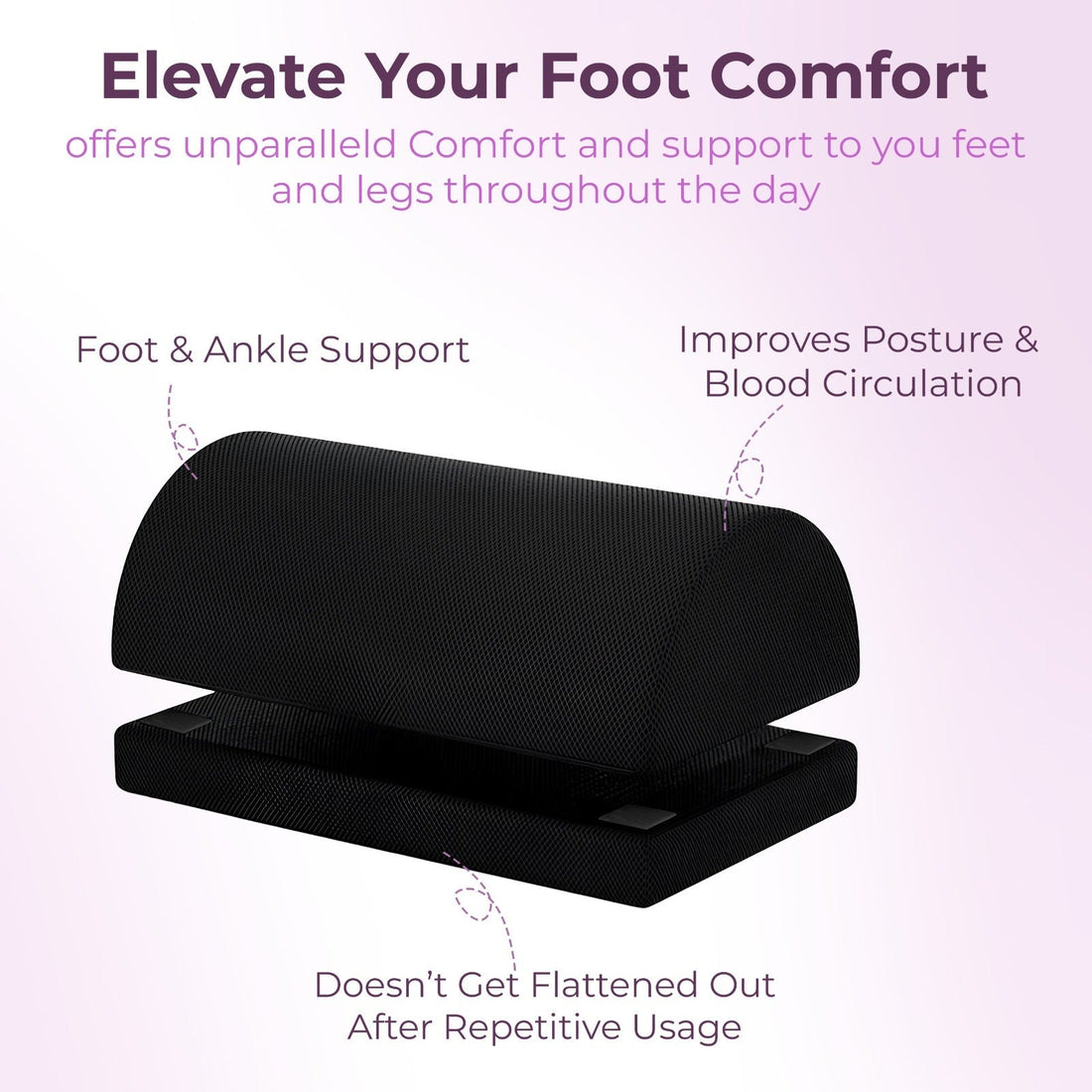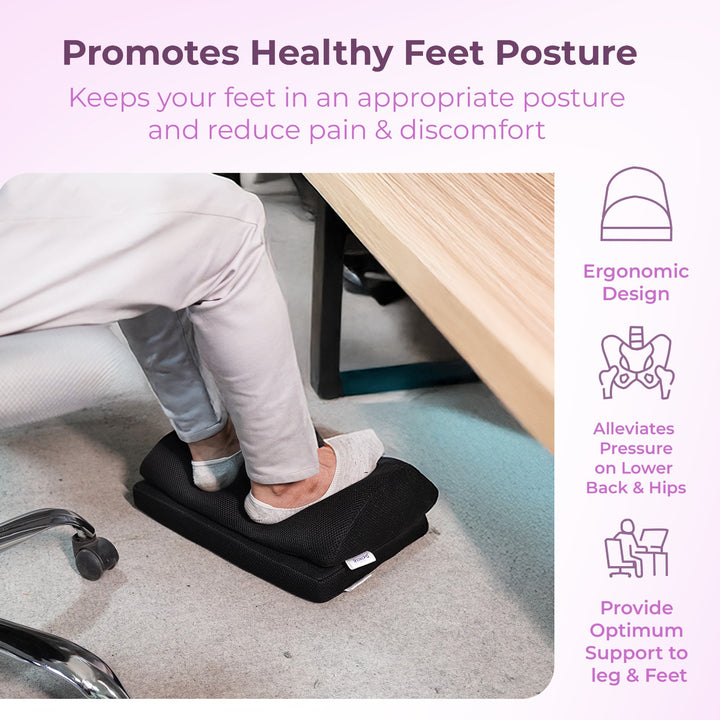
Which Is Better for Support: Memory Foam Footrest Pillow or Conventional Footrests?
Share
It is impossible to overestimate the significance of a good footrest in designing a pleasant and ergonomic workstation. Your posture and general comfort have a big impact on your health and productivity, whether you're working from home, in an office, or playing video games for hours on end. Footrests are made of different materials and styles and are intended to improve posture and offer support. Traditional footrests and memory foam footrest pillows are two of the most widely used types.
In this blog, we’ll delve into the key differences between memory foam footrest pillows and traditional footrests, evaluating their support, comfort, usability, and overall benefits. By the conclusion, you’ll have a clear grasp of which choice suits your needs better.
Memory Foam Footrest Pillows: What Are They? Memory foam footrest pillows are soft, cushion-like supports that are typically made from viscoelastic foam. These footrests have several great features, such as an ergonomic design that puts your feet up, a removable, washable cover, and a relatively light weight that allows you to use them in a variety of settings.

Memory foam footrest pillows' salient features include:
Foot up for ergonomic design.
intended to encourage proper posture.
Gentle but encouraging
It relieves pressure by offering a harmonious combination of support and cushioning.
Adaptable usage. Depending on the situation, it can be positioned under the knees or on the feet.
Lightweight and portable
Which footrests are considered traditional?
The majority of conventional footrests are constructed from bulky materials like metal, wood, and plastic. Many may be angled and height-adjusted to accommodate people with varying ergonomic requirements. Conventional footrests should be placed beneath the desk because they are made to be immobile. Offices are to make use of them.
Important characteristics of a conventional footrest
Due to the use of substantial materials, the conventional footrest is robust.
Most models have angles and heights.
Stability: Heavy and slip-resistant constructions that will not shift around.
Professional Appearance: Generally made to fit in with the rest of workplace furnishings.
Comfort and Support
Pillows with Memory Foam Footrests
Memory foam footrests are exceptional for offering soft, customized support. The foam shapes itself to your feet's natural curves, thereby eliminating pressure points and improving blood flow. Such personalized support is particularly beneficial to those who have been experiencing pain, swelling, or fatigue on their feet following hours of sitting.
Good for extended use periods.
For persons with fragile feet or suffering from plantar fasciitis, advised
Drawbacks
does not provide users with enough elevation
As it becomes heavier over time, the stiffness is lost.
Traditional Footrests
Conventional footrests provide more organized posture correction and stiff support. They are adaptable to all body shapes and workplace arrangements because adjustable ones allow users to get the ideal height and angle. For extended use, they are less pleasant than memory foam, nevertheless.

Advantages
very customizable for precise ergonomics.
provides consistent assistance over time.
incredibly robust and long-lasting.
Drawbacks
A harder surface might not be as cozy.
heavier and more difficult to transport.
Versatility and Usability
Pillows with Memory Foam Footrests
Footrests made of memory foam are very adaptable. They can be used as a knee or lumbar support pillow for sleeping, thus they are more than just a footrest. You may take them with you because they are lightweight and portable.
Benefits:
Adaptable features
Light and portable for storing.
Excellent for a variety of settings, including a flight or the home workplace.
Drawbacks:
On slick conditions, less stable.
compressed while being used continuously.
Conventional Footrest
The conventional footrest is primarily intended to be placed beneath a desk. It gains additional ergonomic adaptability and stability, but not functionality. The larger, heavier variety is less portable and requires less storage space.
Benefits:
has a powerful position.
For use in offices where desk placements are movable.
Suitable for professional use in workplaces
Drawbacks:
can only be utilized with a desk.
challenging to move.
Sturdiness and Upkeep
Pillows with Memory Foam Footrests
Memory foam footrests frequently come with an easily washable, detachable cover. But as its constituent parts degrade, the foam will lose its firmness and shape, particularly if it is used often.
Advantages:
Simple to clean.
Covers are typically interchangeable.
Cons:
Foam may become less hard or shaped.
not as sturdy as conventional footrests.
Conventional Footrests
Footrests are made of materials that are incredibly durable and long-lasting. Only a routine dusting or clearing away dust that has gathered on its surface is probably involved. Those who place a high value on hygiene may find the product's lack of a detachable and washable cover offensive.
Advantages
incredibly robust
less work on the cleaning.
Drawbacks
tougher to clean than other kinds of memory foam.

Difference in Cost
Because memory foam footrests are less expensive than standard footrests, they are the best choice if you're looking for a product that offers basic ergonomic support at a reasonable price. Due to improvements in practicality and durability, traditional footrests—especially adjustable ones—tend to be more expensive.
Pillows with Memory Foam Footrests $20 to $50
Conventional Footrests: $40 to $150, based on the materials and functionality.
Which one to pick
It all boils down to your own needs, tastes, and working environment. To determine what could be best for you, use this brief guide:
Select a Footrest Pillow Made of Memory Foam If:
Comfort is sacrificed for adaptability.
You're looking for something portable and lightweight.
You suffer from ailments like plantar fasciitis or are sensitive about your feet.
You have a limited budget.
Select a Conventional Footrest if:
You require a highly ergonomic and adjustable device.
It must be long-lasting and robust.
You want a stable, non-slip design for desk use.
You want a professional look that matches your office setup.
In conclusion
Memory foam footrest cushions and regular footrests both have their perks. Neither is better than the other; rather, one will suit your needs better than the other based on what you are searching for in a product. Memory foam footrest pillows would be perfect for their soft cushioning and flexibility. However, a standard footrest will be far more suitable for a more serious work setting, particularly if it must be precisely and accurately adjusted.
Whatever your preference, using a footrest can now be a comfortable way to improve your comfort and wellbeing at work.
